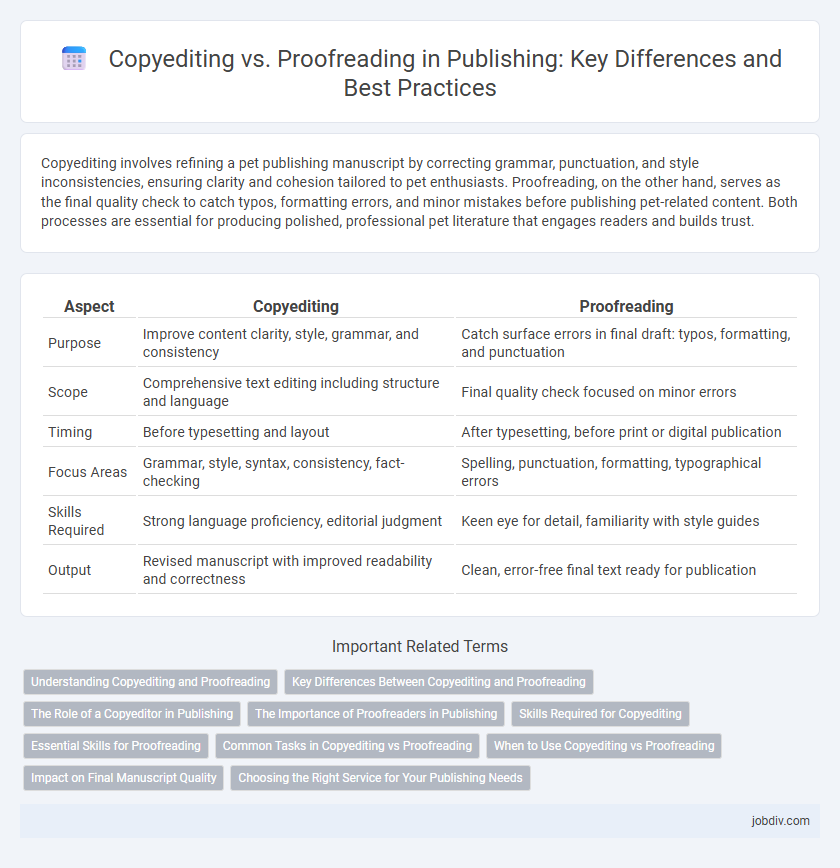Copyediting involves refining a pet publishing manuscript by correcting grammar, punctuation, and style inconsistencies, ensuring clarity and cohesion tailored to pet enthusiasts. Proofreading, on the other hand, serves as the final quality check to catch typos, formatting errors, and minor mistakes before publishing pet-related content. Both processes are essential for producing polished, professional pet literature that engages readers and builds trust.
Table of Comparison
| Aspect | Copyediting | Proofreading |
|---|---|---|
| Purpose | Improve content clarity, style, grammar, and consistency | Catch surface errors in final draft: typos, formatting, and punctuation |
| Scope | Comprehensive text editing including structure and language | Final quality check focused on minor errors |
| Timing | Before typesetting and layout | After typesetting, before print or digital publication |
| Focus Areas | Grammar, style, syntax, consistency, fact-checking | Spelling, punctuation, formatting, typographical errors |
| Skills Required | Strong language proficiency, editorial judgment | Keen eye for detail, familiarity with style guides |
| Output | Revised manuscript with improved readability and correctness | Clean, error-free final text ready for publication |
Understanding Copyediting and Proofreading
Copyediting involves reviewing and correcting grammar, punctuation, syntax, and style consistency to ensure clear and polished content. Proofreading is the final step focused on detecting and fixing typographical errors, formatting issues, and minor mistakes before publication. Understanding the distinct roles of copyediting and proofreading improves manuscript quality and streamlines the publishing process.
Key Differences Between Copyediting and Proofreading
Copyediting involves a comprehensive review of grammar, style, and consistency to enhance the clarity and flow of a manuscript, while proofreading is the final step focused on detecting surface errors like typos, spelling mistakes, and formatting issues. Copyeditors address structural and linguistic elements, ensuring adherence to style guides and improving overall readability, whereas proofreaders concentrate solely on correcting minor errors before publication. Understanding these key differences is essential for maintaining high-quality publishing standards and ensuring error-free final documents.
The Role of a Copyeditor in Publishing
A copyeditor in publishing meticulously reviews manuscripts to enhance clarity, consistency, grammar, and style, ensuring the text aligns with the publisher's standards. Their role extends beyond simple error correction to include fact-checking, structural adjustments, and maintaining the author's voice while improving readability. Unlike proofreading, which is the final error check, copyediting is an earlier, more comprehensive process critical for producing polished and professional publications.
The Importance of Proofreaders in Publishing
Proofreaders play a crucial role in publishing by ensuring the final manuscript is free from typographical errors, spelling mistakes, and formatting inconsistencies that can undermine the professionalism of a publication. Their meticulous attention to detail guarantees that all textual elements align with style guides and publication standards, enhancing the overall readability and credibility of the work. By catching errors that copyediting might overlook, proofreaders help maintain the integrity and quality of published content.
Skills Required for Copyediting
Copyediting requires a strong command of grammar, punctuation, and syntax to ensure clarity and consistency in the text. Attention to detail and familiarity with style guides such as APA, MLA, or Chicago Manual of Style are essential for maintaining the author's voice while correcting errors. Proficiency in fact-checking and the ability to identify logical inconsistencies further distinguish copyediting from basic proofreading tasks.
Essential Skills for Proofreading
Essential skills for proofreading include a keen eye for detail, strong command of grammar, punctuation, and spelling, and the ability to identify inconsistencies or typographical errors. Mastery in recognizing formatting issues and the capability to maintain the author's original voice are crucial for delivering polished, publication-ready manuscripts. Effective proofreaders also possess patience and concentration to thoroughly review texts and ensure error-free content.
Common Tasks in Copyediting vs Proofreading
Copyediting involves tasks such as correcting grammar, punctuation, syntax, consistency in style, and improving overall clarity and flow of the text. Proofreading focuses primarily on identifying and fixing minor errors like typos, spelling mistakes, and formatting inconsistencies before final publication. Both stages are essential in the publishing process to ensure polished, professional content and error-free manuscripts.
When to Use Copyediting vs Proofreading
Copyediting is essential during the manuscript development stage to enhance clarity, grammar, consistency, and overall flow, ensuring the text meets style guidelines and is free of substantive errors. Proofreading is the final step before publication, focusing on identifying and correcting minor typographical errors, formatting issues, and punctuation mistakes. Writers and publishers use copyediting when the content requires structural and language refinement, while proofreading is reserved for quality control to catch overlooked errors after all major edits are complete.
Impact on Final Manuscript Quality
Copyediting enhances the final manuscript quality by addressing grammar, syntax, consistency, and style, ensuring clarity and coherence throughout the text. Proofreading is crucial for eliminating surface errors such as typos, punctuation mistakes, and formatting inconsistencies that can distract readers and undermine professionalism. Both processes collectively elevate the manuscript's readability and credibility, making them essential steps in the publishing workflow.
Choosing the Right Service for Your Publishing Needs
Copyediting ensures clarity, consistency, and style adherence by addressing grammar, punctuation, and syntax errors, making it essential for content refinement before publication. Proofreading is the final quality check focused on detecting minor typos, formatting issues, and surface-level errors after typesetting. Choosing the right service depends on the manuscript's stage and depth of editing required to achieve polished, professional publishing standards.
Copyediting vs Proofreading Infographic

 jobdiv.com
jobdiv.com